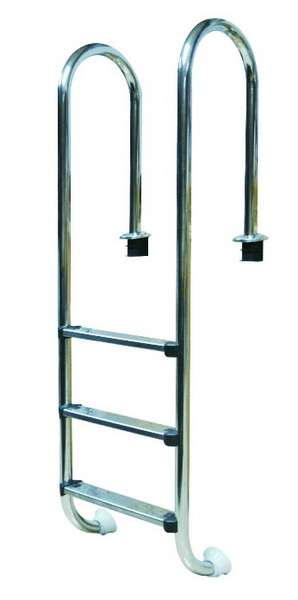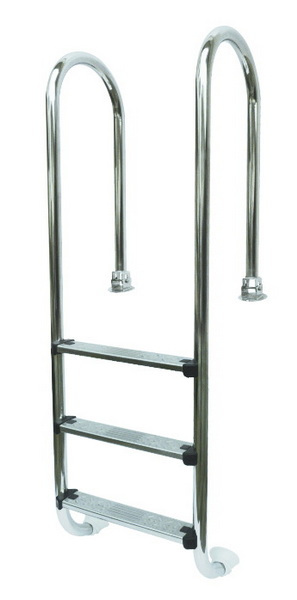Views: 222 Author: Tina Publish Time: 2025-10-17 Origin: Site








Content Menu
● General construction approach
● Safety features and compliance
● Finishing touches and aesthetics
● OEM/ODM considerations for manufacturers
● FAQs
>> 1) What is the recommended load capacity for an above-ground pool ladder?
>> 2) What materials resist pool chemicals the best?
>> 3) How do you install an above-ground pool ladder securely?
>> 4) How often should ladder components be inspected?
>> 5) Can ladders be used with saltwater pools?
This article is designed for international buyers and manufacturers seeking OEM guidance and practical insights into building a sturdy, safe, and durable above-ground pool ladder. We will cover design considerations, materials, step-by-step construction concepts, safety features, and maintenance tips. While this piece emphasizes a broad overview suitable for planning and sourcing, always refer to local safety standards and manufacturer specifications when finalizing a product. We will also discuss how a Chinese factory with OEM capabilities can support foreign brands with ODM/OEM solutions for pool filtration and related accessories.

An above-ground pool ladder should provide safe ingress and egress while withstanding pool chemistry, weather, and regular use. Important factors include:
- Load capacity: Ensure the ladder supports at least 300–400 pounds (140–180 kg) for residential pools, with a margin for safety.
- Slip resistance: Use textured treads and anti-slip surfaces to prevent falls, even when wet.
- Stability: A wide base, non-slip feet, and secure mounting to the pool deck or pool wall are essential.
- Materials: Corrosion-resistant options (e.g., marine-grade aluminum or stainless steel) outperform cheaper metals in pool environments.
- Height compatibility: Ladder height should match the pool wall height and deck clearance.
- Access ergonomics: Treads should be comfortable, spaced appropriately, and the handrails should offer a secure grip.
For durability in chlorinated water and outdoor exposure, consider:
- Frame: Aluminum with anodized finish or stainless steel for corrosion resistance.
- Treads: Textured aluminum, plastic, or composite materials that resist slipping.
- Handrails: Aluminum or stainless steel with protective coatings.
- Fasteners: Stainless steel hardware (A2 or A4 grade) to resist corrosion.
- Mounting hardware: Waterproof anchors or deck mounting systems suitable for your pool type.
1) Measure and plan:
- Confirm pool wall height, deck thickness, and mounting points.
- Decide on fixed vs. removable ladder design based on usage and maintenance.
2) Cut and prepare components:
- Cut frames and rungs to exact lengths using appropriate tools.
- Deburr edges to prevent injuries.
3) Assemble the frame:
- Begin with the side rails, attach cross supports, and ensure squareness.
- Install treads with non-slip surfaces at comfortable intervals.
4) Attach handrails:
- Securely anchor handrails to provide a stable grip.
- Add rubber grips or protective sleeves where applicable.
5) Mounting and installation:
- Use corrosion-resistant anchors to secure the ladder to the pool deck or wall.
- Check for wobble and ensure all fasteners are tightened.
6) Safety checks:
- Verify load capacity, check for sharp edges, and confirm secure mounting.

- Guard features: Where applicable, add barriers or barriers at the top to prevent accidental falls.
- Non-slip surfaces on steps.
- Rounded edges and smooth corners to minimize injury risk.
- Compliance: Align with local safety standards (e.g., ASTM, ISO, or regional equivalents).
- Anodized or powder-coated finishes for longevity and appearance.
- Optional protective covers for outdoor storage.
- Color options to match pool aesthetics.
- Regularly inspect fasteners and tolerances for loosening.
- Clean steps and handrails to remove algae and grime.
- Check for corrosion and replace any damaged components promptly.
As a professional Chinese factory offering OEM services, we can assist foreign brands with:
- Design customization for ladder dimensions, materials, and finishes.
- Private labeling and packaging customization.
- Quality control processes, testing, and documentation for export markets.
- Integrated solutions: pairing ladders with compatible pool filters, pumps, LED lighting, and other accessories.
This article provides a comprehensive framework for designing, manufacturing, and marketing above-ground pool ladders with OEM/ODM capabilities. It covers robust design principles, material choices, construction methods, safety features, and compliance considerations essential for international markets. By integrating product families (filters, pumps, LED lighting) and offering multilingual documentation and private labeling, manufacturers can deliver complete, reliable pool solutions that meet diverse regulatory and customer requirements. A well-executed OEM program reduces time-to-market, enhances brand consistency, and supports sustainable, long-term partnerships with global buyers.

- Answer: A typical residential ladder should support at least 300–400 pounds (136–181 kg) for safety margins, depending on manufacturer guidelines. [To be confirmed with your product specs]
- Answer: Aluminum with anodized finish or stainless steel components are most resistant to chlorinated water and outdoor exposure.
- Answer: Ensure proper mounting to the deck or pool wall using corrosion-resistant anchors, tighten all fasteners, and check for stability before use.
- Answer: Check quarterly for loosened fasteners, corrosion, and wear; perform a full inspection annually.
- Answer: Yes, but choose materials rated for saltwater environments and maintain corrosion protection and coatings.
This guide explains how to safely increase pressure on a pool pump by restoring healthy water flow. Learn to diagnose low pressure, clean baskets and filters, fix air leaks, adjust valves and pump speed, and know when equipment upgrades or gauge replacement are necessary.<br />
This in‑depth guide explains how much it costs to replace a pool pump, covering typical price ranges, pump types, labor charges, and long‑term energy savings. Learn when to repair vs replace, DIY vs professional options, and how OEM pump and filter solutions can reduce lifetime ownership cost.<br />
Learn exactly how long to run a pool pump daily for crystal‑clear, safe water and lower energy bills. This in‑depth guide explains turnover, seasonal adjustments, single‑ vs variable‑speed schedules, energy‑saving tips, and practical examples, plus answers to common runtime questions.
This in‑depth guide explains the real reasons your swimming pool pump is not working, from power and priming issues to clogged impellers, dirty filters, and motor failures. Learn step‑by‑step troubleshooting, key maintenance tips, and when to repair or replace your pool pump.
Learn how to remove a pool pump motor safely and efficiently with this step‑by‑step guide. Discover the tools you need, how to disconnect power and plumbing, when to call a pro, and how OEM filter and pump solutions can support overseas pool brands and wholesalers.<br />
This article introduces leading Pool Cleaning Equipment Manufacturers and Suppliers in the UK, outlines their key products, and explains how international brands can combine UK distributors with Chinese OEM factories to build competitive, high‑quality private‑label pool cleaning and filtration lines.
This article outlines the leading Pool Cleaning Equipment Manufacturers and Suppliers in America, explains key product categories such as sand filters, pumps, and robotic cleaners, and shows how importers can combine U.S. brands with Chinese OEM partners to build competitive, high‑margin pool equipment portfolios.<br />
This article introduces the European market for pool equipment and accessories, profiles key Pool Cleaning Equipment Manufacturers and Suppliers, and explores OEM opportunities for Chinese factories producing sand filters, pumps, cleaners and LEDs for European brands and wholesalers.<br />
This article profiles top Pool Filter Valve Manufacturers and Suppliers in Canada, including Praher Plastics, global brands like Hayward and Carvin, and leading distributors. It explains key valve types, buying factors, and how foreign OEM factories can partner with Canadian suppliers for complete pool filtration solutions.<br />
Discover top Pool Filter Valve Manufacturers and Suppliers in Korea, from Korea Filter to SEDA, offering innovative multiport valves, OEM services, and eco-friendly designs for global pools. Explore advancements, certifications, and FAQs in this comprehensive guide to superior filtration solutions.
This article introduces leading Pool Filter Valve Manufacturers and Suppliers in Japan and Asia, covering valve types, key Japanese pool brands, OEM opportunities, and application segments. It explains how advanced engineering, strict quality control, and strong visual marketing help exporters win global pool projects.
This article introduces the main types of Pool Filter Valve Manufacturers and Suppliers serving Russia, including local distributors, industrial filter producers, global brands, and Chinese OEM partners. It explains key selection criteria, product ranges, and OEM opportunities for Russian pool projects.<br />
This article introduces the leading Pool Filter Valve Manufacturers and Suppliers in Australia, explains common valve types and technical features, highlights major distributors and OEM opportunities, and offers practical tips for international buyers sourcing compatible filtration valves and systems.
This article introduces Italy’s leading Pool Filter Valve Manufacturers and Suppliers, detailing their technologies, materials, OEM services, and application scenarios. It explains how Italian valves integrate with sand, DE, and cartridge filters and why global brands choose Italian partners for premium pool filtration solutions.<br />
This article introduces the Portuguese market for pool filtration equipment and highlights how local specialists, European brands, and Chinese OEM Pool Filter Valve Manufacturers and Suppliers cooperate to serve residential and commercial pools, offering multiport valves, filters, pumps, and customized OEM solutions.<br />
This article explains whether you can safely use pool filter sand in an aquarium, covering sand types, preparation, pros and cons, plant and fish compatibility, maintenance tips, and alternatives. It helps hobbyists choose and manage substrate using pool-grade filtration media.
This article explains when to backwash a pool filter using pressure readings, water clarity and flow as guides. It covers sand and DE filter schedules, backwash steps, common mistakes, troubleshooting cloudy water, and how OEM sand filter systems can simplify maintenance for global pool owners.<br />
This article explains what pool filter balls are, how they work, and why they are an increasingly popular alternative to sand in residential pool filters. It covers benefits, installation, maintenance, compatibility, and OEM opportunities for brands seeking high‑performance filtration solutions.<br />
This article explains how often to change a pool filter cartridge, covering typical 1–3 year lifespans, signs of wear, and factors like usage, climate, and maintenance. It shows how cleaning frequency, pressure readings, and water clarity guide replacement and highlights the value of OEM cartridge solutions.
This article explains how often to change a pool filter cartridge, covering typical 1–3 year lifespans, factors that affect replacement timing, and clear signs of wear. It outlines cleaning versus replacement, residential vs commercial schedules, and highlights OEM cartridge solutions for complete pool filtration systems.<br />
